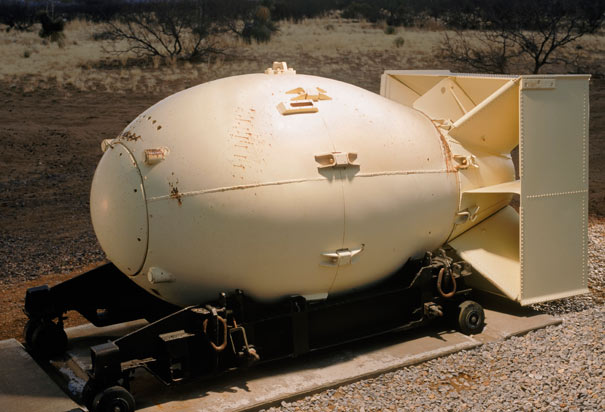The Nagasaki Bomb
About midmorning the two B-29 "Bockscar" and "Great Artiste" arrived over Nagasaki. But as had happened in Kokura, the city was completely covered by clouds and wasn´t visible. For a while they were hanging around hoping that heaven stayed clear, although it wasn’t possible. At 11:00 the order of returning to the plane was given, then, just when the "Bockscar" was about to leave, the bomber Kermit Beahan saw through the peephole a small gap between the clouds where some buildings in Nagasaki could be seen. Without hesitation, the "Bockscar" made a quick approach manoeuvre and broke its "Fat Mat" atomic bomb, which swiftly fell sharply at 11:01.
At 560 meters above the ground, the atomic bomb "Fat Man"
exploded at 11:02 a.m. on August 9th, 1945. With an initial Flash ten times greater than the Sun that blinded everyone; the explosion had an output of 20,000 tons of TNT, an unmatched force in the world. The epicenter of the atomic explosion, one square kilometer around the North industrial district, was disintegrated entirely due to the 3,000 degrees, including a Catholic Church that was melted almost to its foundations. Two kilometers further in, the destruction of homes and buildings also were complete, as for example the Sofukuji Temple and Mitsubishi arms factory. Subsequently rose a wind of 1,500 kilometers per hour that ripped houses from the ground, taking with trees, stores and people up to four kilometers away. Finally, coinciding with a radioactive black rain, rose a fungus in the sky which was spectacular, as he ascended to the 18′ 5 kilometers high.
At 560 meters above the ground, the atomic bomb "Fat Man"
exploded at 11:02 a.m. on August 9th, 1945. With an initial Flash ten times greater than the Sun that blinded everyone; the explosion had an output of 20,000 tons of TNT, an unmatched force in the world. The epicenter of the atomic explosion, one square kilometer around the North industrial district, was disintegrated entirely due to the 3,000 degrees, including a Catholic Church that was melted almost to its foundations. Two kilometers further in, the destruction of homes and buildings also were complete, as for example the Sofukuji Temple and Mitsubishi arms factory. Subsequently rose a wind of 1,500 kilometers per hour that ripped houses from the ground, taking with trees, stores and people up to four kilometers away. Finally, coinciding with a radioactive black rain, rose a fungus in the sky which was spectacular, as he ascended to the 18′ 5 kilometers high.
Nagasaki was the fatal and final blow that would fall on their knees to the Japan and force to surrender unconditionally. The destruction of that city in Kyushu finally confirmed all suspicions to the Emperor Hiro-Hito and its dome, which made them understand that the war was more than lost. The cause of the atomic bomb in Nagasaki 70,000 people died instantly, that, with the passage of time, would be expanded to 170,000 because of disease or radioactive burns. There were 60,000 wounded and 70% of the buildings were destroyed. Curiously, there were 8 allies who died in Nagasaki, seven Dutch soldiers and a British, since they were imprisoned at the time of the explosion.

